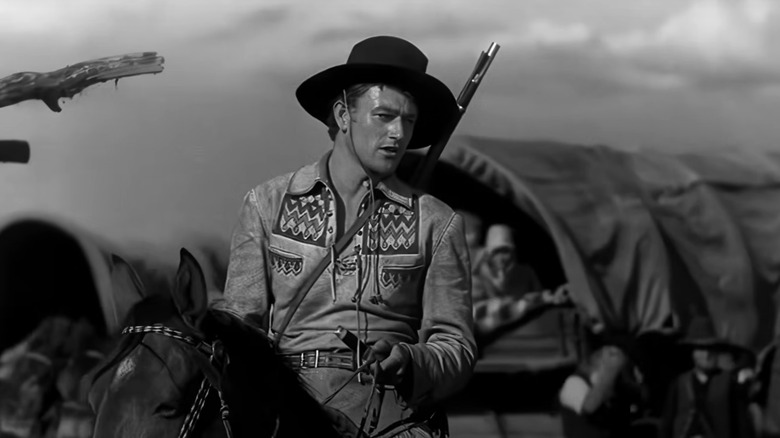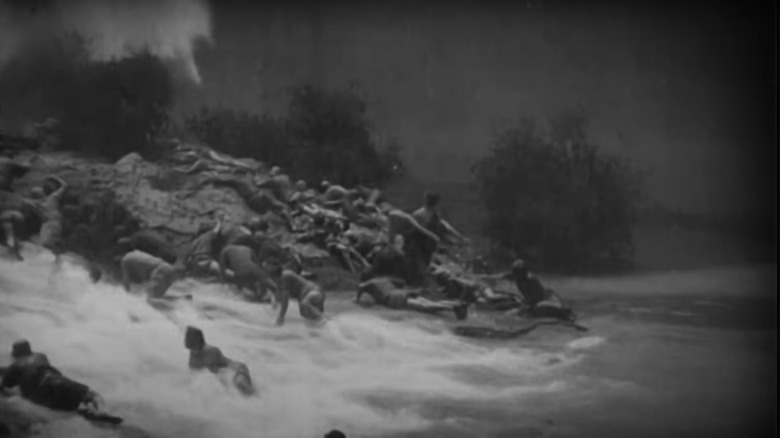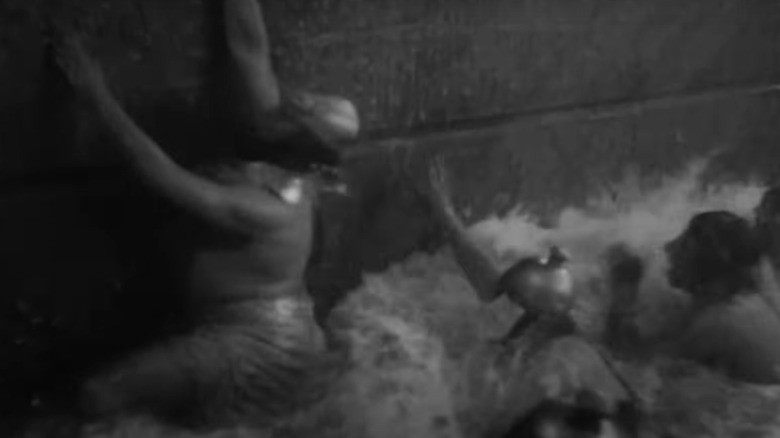The Movie Stunt That Almost Killed John Wayne Before His Rise To Fame
We may receive a commission on purchases made from links.
Long before he became arguably the most famous actor in the world, John Wayne started his career by literally knocking over director John Ford. Given how Ford would go on to treat Wayne and many other actors on set, it's quite satisfying to know Duke managed to get in a good hit on the director before he was subjected to the man's penchant for emasculating his male stars. Despite their contentious relationship (which didn't seem to sour Wayne on Ford in the end), the filmmaker clearly saw something in Wayne, as evidenced by the fact he was largely responsible for kickstarting his acting career.
The director first encountered the young USC student lugging around props on a set back in the mid-1920s, and cast Wayne in 1928's "Hangman's House," in which he played a spectator at a horse race (though he didn't have any lines). Wayne would have to wait until 1939's "Stagecoach" to actually star in a major Ford picture and break into the big leagues, and between 1926 and that major starring role, the actor famously made his living starring in multiple low-budget Western productions. But that wasn't all Wayne was up to while he waited for his first starring role in an "A" picture. The young actor's filmography is full of small-budget romantic dramas and even the odd biblical epic, such as "Noah's Ark," which debuted the same year as "Hangman's House."
This part-talkie epic disaster outing was directed by Michael Curtiz from a story by Darryl F. Zanuck. The writer would later co-found 20th Century Fox (as it was known before the Disney/Fox merger of 2019) and become one of Hollywood's most notable creeps, very much helping to establish the seedy casting couch convention that remains one of the industry's most shameful contributions to culture. (He also offered to pay $25,000 of his own money just to shave Gregory Peck's face, but I digress.)
"Noah's Ark" was a retelling of the biblical tale alongside a story set during World War I. Dolores Costello and George O'Brien appear in both stories as a couple whose love is threatened by the arrival of World War I in the modern tale, and the biblical deluge in the other. Aside from that rather unorthodox conceit, the movie is memorable for a much more upsetting reason in that it resulted in the deaths of three extras, the maiming of another, and the crippling of half a dozen more. It also nearly killed John Wayne.
The flood scene in Noah's Ark was a disaster waiting to happen
"Noah's Ark" arrived at a point when films were transitioning from the silent era to talkies, which resulted in Michael Curtiz's biblical epic being released with several dialogue sequences intercut with scenes that featured a musical score. But for Curtiz, the big draw wasn't necessarily the inclusion of newfangled dialogue recording, it was the big flood scene that closed the film. Sadly, this depiction of God's wrath being unleashed upon the people turned out to be lethal.
According to author Fred Landesman and his book "The John Wayne Filmography," 3,500 extras were used on the movie, while Michael and Harry Medved's "The Hollywood Hall of Shame: The Most Expensive Flops in Movie History" puts the number at 7,500. Whatever the actual figure, not all of these extras would make it out alive ... or even in one piece.
The climax of the movie sees the Temple of Moloch flooded after Jehovah unleashes his wrath. This impressive set was built within what was known as a "studio tank," which basically means a large concrete lake. 15,000 tons of water were held in multiple reservoirs, and were released onto the set via chutes hidden in the temple columns. The extras' job was to simply take the brunt of this flood and panic for a while amid the catastrophe. But it might not surprise you to learn that things didn't exactly go to plan.
Noah's Ark proved fatal, but John Wayne survived
As recounted in "The Hollywood Hall of Shame: The Most Expensive Flops in Movie History," cameraman Hal Mohr had major reservations about the big flood scene right from the off. "When they started talking about how to do it, I objected," he said. "Not as a cameraman, but as a human being, for Christ sake, because it seemed to me they were going to kill a few people with these tons of water and huge sets falling on them." According to Mohr, the production used stuntmen who "knew what they were doing," but also used hundreds of other extras who had no training whatsoever. This resulted in Mohr abandoning the film. "I told them to shove the picture, and walked off the set." Sadly, Mohr's predictions about "killing a few people" turned out to be right.
When the 15,000 tons of water were released, the extras suddenly found themselves literally fighting for their lives. The strength of the water proved too much for some, and three extras were killed during filming, while another lost a leg. Half a dozen more reportedly suffered broken bones. Amid the chaos were reportedly future stars Ward Bond, Andy Devine, and John Wayne, all of whom were extras on "Noah's Ark" and all of whom came very close to having their careers cut short — though it should be noted that while Wayne is listed as having been an extra in the movie, there's no record of him discussing this horrific moment and he's not visible on-screen during the flood. Then again, the scenes are so chaotic it's hard to make anyone out.
Despite this horrific event, neither Michael Curtiz nor Daryl F. Zanuck suffered any consequences. As Medved wrote, Zanuck and his cohorts "merely shrugged their shoulders with the implied comment, 'That's show business,' and did their best to keep the scandalous story out of the newspapers." Sadly, such occurrences weren't all that rare at the time. In "Stunt; The Story of the Great Movie Stunt Men" by John Baxter, the author notes how three more men died in rapids that same year while shooting Clarence Brown's "The Trail of '98." While things have improved dramatically since 1928, on-set accidents continue to this day and have occurred multiple times in the years since "Noah's Ark." At the very least, we can be grateful Curtiz's film spared a young John Wayne.


